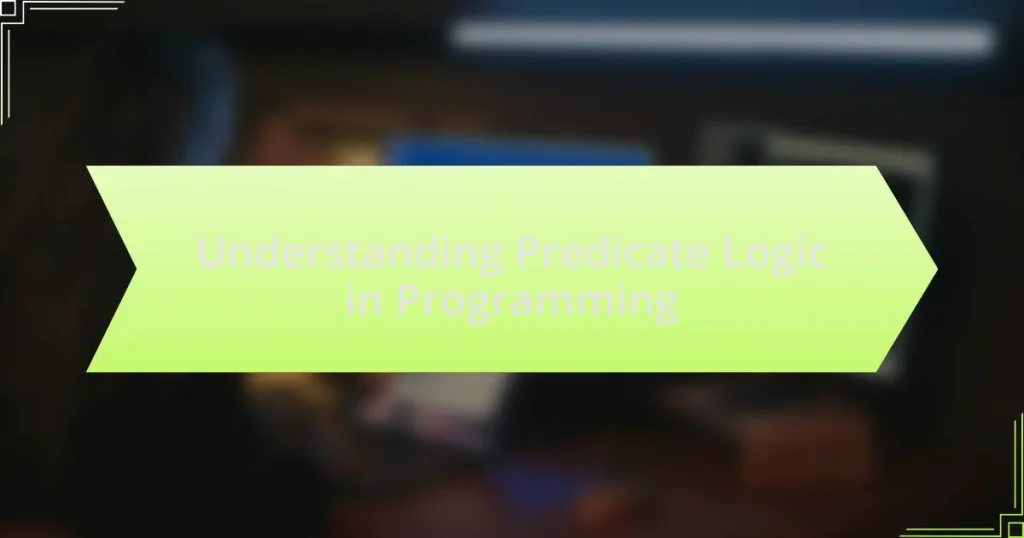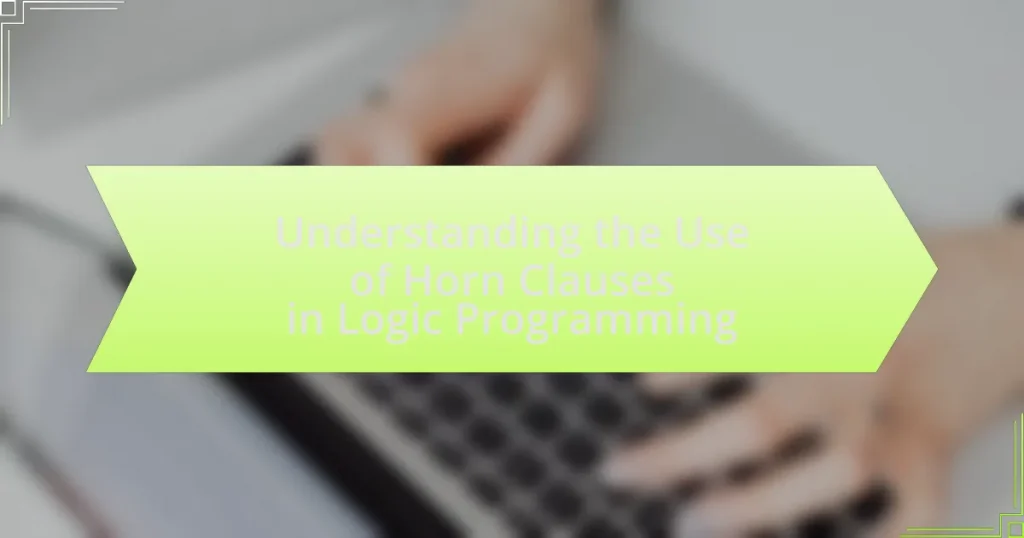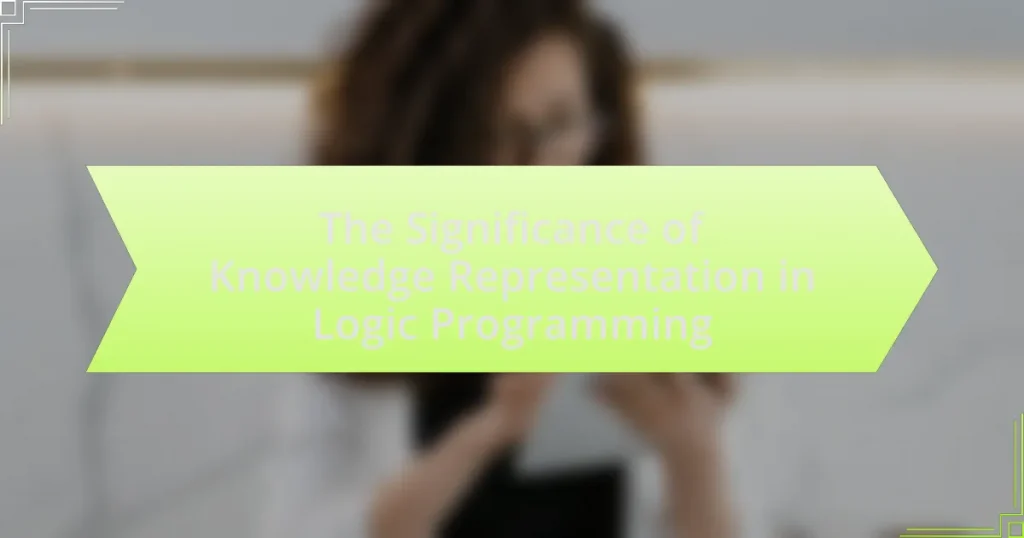Declarative programming is a fundamental aspect of logic programming, allowing developers to express the logic of computation without detailing control flow. This paradigm emphasizes the desired outcomes of programs, leading to clearer, more maintainable code and reducing the likelihood of errors. The article explores the differences between declarative and imperative programming, key characteristics of declarative programming, its significance in modern software development, and its practical applications in fields such as artificial intelligence and database management. Additionally, it addresses the challenges of implementing declarative programming and discusses future trends and best practices for developers.
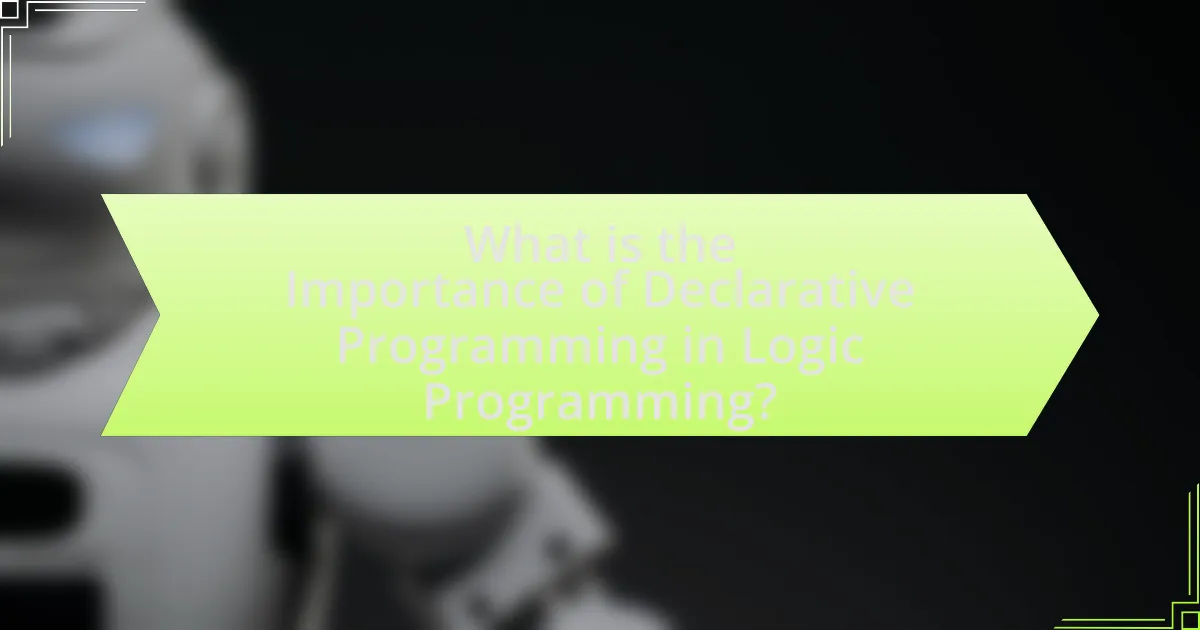
What is the Importance of Declarative Programming in Logic Programming?
Declarative programming is crucial in logic programming as it allows developers to express the logic of computation without detailing control flow. This paradigm emphasizes what the program should accomplish rather than how to achieve it, leading to clearer and more concise code. For instance, in Prolog, a prominent logic programming language, developers define relationships and rules, enabling the system to infer solutions based on logical reasoning. This approach enhances maintainability and reduces the likelihood of errors, as the focus shifts from procedural steps to logical assertions. The importance of declarative programming in logic programming is thus underscored by its ability to simplify complex problem-solving through a more intuitive representation of logic.
How does Declarative Programming differ from Imperative Programming?
Declarative programming differs from imperative programming in that it focuses on what the program should accomplish rather than how to achieve it. In declarative programming, developers specify the desired outcomes and the underlying system determines the execution details, which contrasts with imperative programming where developers provide explicit instructions on how to perform tasks step-by-step. For example, SQL is a declarative language that allows users to specify what data to retrieve without detailing the process of data retrieval, while languages like C or Java require detailed procedural instructions to manipulate data. This distinction highlights the abstraction level in declarative programming, which can lead to more concise and maintainable code.
What are the key characteristics of Declarative Programming?
Declarative programming is characterized by its focus on what the program should accomplish rather than how to achieve it. This paradigm emphasizes high-level abstractions, allowing developers to express logic without detailing control flow. Key characteristics include the use of expressions and declarations to define desired outcomes, immutability of data, and the ability to leverage built-in functions and libraries for complex operations. Additionally, declarative programming often leads to more concise and readable code, facilitating easier maintenance and understanding. These traits are evident in languages such as SQL for database queries and HTML for web page structure, where the programmer specifies the result rather than the steps to obtain it.
Why is Declarative Programming considered more intuitive?
Declarative programming is considered more intuitive because it allows developers to express what the program should accomplish without detailing how to achieve that outcome. This high-level abstraction aligns closely with human reasoning, making it easier for programmers to understand and manipulate code. For instance, languages like SQL enable users to specify the desired result of a query rather than the procedural steps to retrieve it, which simplifies the cognitive load on the programmer. Studies have shown that this approach reduces the likelihood of errors and enhances productivity, as developers can focus on problem-solving rather than implementation details.
What role does Logic Programming play in Declarative Programming?
Logic Programming serves as a fundamental paradigm within Declarative Programming by emphasizing the expression of logic and relationships over control flow. In this context, Logic Programming allows developers to specify what the program should accomplish rather than detailing how to achieve it, aligning with the core principles of Declarative Programming. This approach facilitates problem-solving through formal logic, enabling the use of rules and facts to derive conclusions, which is exemplified in languages like Prolog. The effectiveness of Logic Programming in Declarative Programming is evidenced by its application in artificial intelligence and database querying, where logical inference is crucial for deriving meaningful results from complex datasets.
How does Logic Programming utilize Declarative principles?
Logic Programming utilizes Declarative principles by allowing programmers to express the logic of a computation without detailing its control flow. This approach emphasizes what the program should accomplish rather than how to achieve it, enabling a focus on problem-solving and high-level reasoning. For instance, in Prolog, a prominent logic programming language, rules and facts are defined declaratively, allowing the system to infer conclusions based on these statements. This method enhances readability and maintainability, as it abstracts the underlying implementation details, making it easier to reason about the program’s behavior.
What are the foundational concepts of Logic Programming?
The foundational concepts of Logic Programming include facts, rules, and queries. Facts represent basic assertions about the world, rules define relationships and infer new information from existing facts, and queries allow users to ask questions about the data represented in the program. These concepts are rooted in formal logic, particularly predicate logic, which provides a framework for reasoning about propositions and their relationships. Logic Programming languages, such as Prolog, utilize these concepts to enable declarative programming, where the focus is on what the program should accomplish rather than how to achieve it. This approach facilitates problem-solving by allowing programmers to express logic in a way that is closer to human reasoning, thus enhancing the clarity and maintainability of code.
Why is Declarative Programming significant in modern software development?
Declarative programming is significant in modern software development because it allows developers to express the logic of computation without detailing the control flow. This paradigm enhances productivity by enabling clearer and more concise code, which is easier to read and maintain. For instance, languages like SQL and HTML exemplify declarative programming, allowing users to specify what they want to achieve rather than how to achieve it. This approach reduces the complexity of code, minimizes errors, and accelerates development cycles, making it particularly valuable in agile environments where rapid iteration is essential.
What advantages does Declarative Programming offer in problem-solving?
Declarative programming offers several advantages in problem-solving, primarily by allowing developers to focus on what the program should accomplish rather than how to achieve it. This abstraction simplifies the coding process, enabling faster development and easier maintenance. For instance, languages like SQL and Prolog allow users to express queries and logic without detailing the control flow, which reduces the potential for errors and enhances readability. Additionally, declarative programming often leads to more efficient execution, as compilers and interpreters can optimize the code better when the intent is clear. This efficiency is evidenced by the widespread use of declarative languages in database management and artificial intelligence, where complex problem-solving is required.
How does Declarative Programming enhance code readability and maintainability?
Declarative programming enhances code readability and maintainability by allowing developers to express the logic of computation without detailing control flow. This abstraction simplifies the code, making it easier to understand and modify. For instance, languages like SQL enable users to specify what data to retrieve rather than how to retrieve it, which reduces complexity. Research indicates that code written in declarative styles is often shorter and clearer, leading to fewer bugs and easier updates, as evidenced by studies showing that teams using declarative languages report higher productivity and lower maintenance costs.
How does Declarative Programming improve efficiency in Logic Programming?
Declarative programming improves efficiency in logic programming by allowing programmers to specify what the program should accomplish without detailing how to achieve it. This abstraction reduces the complexity of code, enabling faster development and easier maintenance. For instance, declarative languages like Prolog allow users to express logic in a way that the underlying system optimizes execution, leading to more efficient resource utilization. Studies have shown that declarative approaches can lead to significant reductions in development time and errors, as they focus on high-level problem-solving rather than low-level implementation details.
What challenges are associated with implementing Declarative Programming?
Implementing Declarative Programming presents several challenges, including difficulty in performance optimization, limited debugging tools, and a steep learning curve for developers. Performance optimization is challenging because declarative languages abstract away the control flow, making it harder to predict and enhance execution efficiency. Limited debugging tools arise since traditional debugging techniques may not apply effectively, complicating the identification of logical errors. Additionally, the steep learning curve is a barrier for developers accustomed to imperative programming paradigms, as they must adapt to thinking in terms of what to achieve rather than how to achieve it. These challenges can hinder the adoption and effective use of declarative programming in various applications.
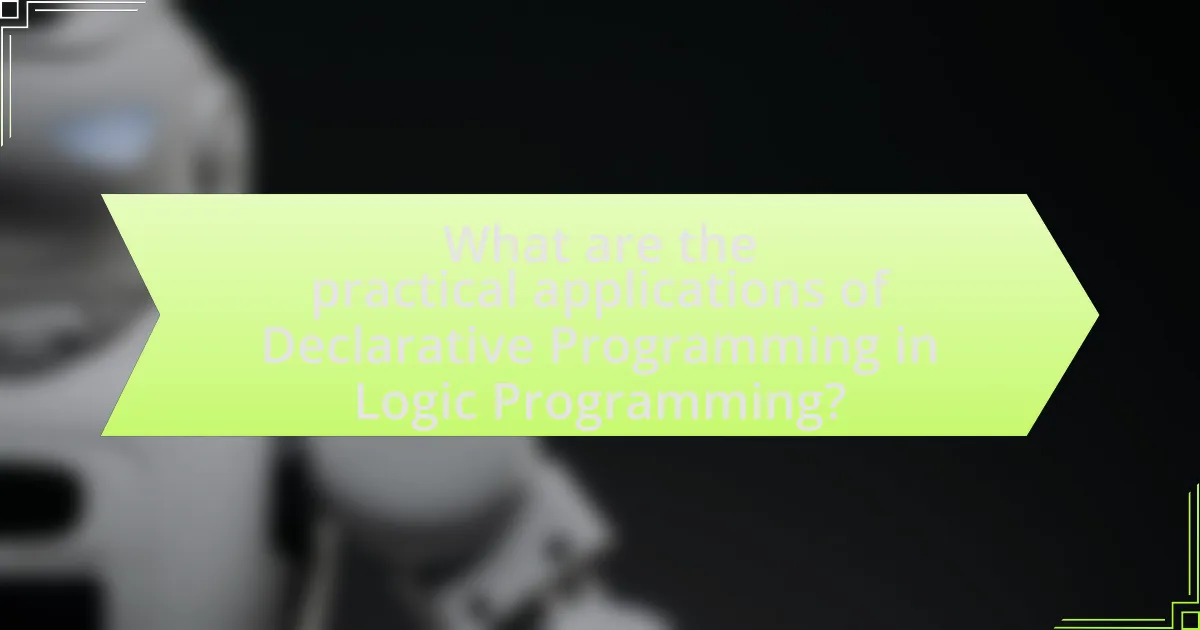
What are the practical applications of Declarative Programming in Logic Programming?
Declarative programming in logic programming has practical applications in areas such as artificial intelligence, database querying, and automated reasoning. In artificial intelligence, declarative languages like Prolog enable the representation of knowledge and facilitate inference, allowing systems to solve complex problems through logical reasoning. In database querying, languages such as SQL utilize declarative paradigms to allow users to specify what data they want without detailing how to retrieve it, enhancing efficiency and readability. Automated reasoning applications leverage declarative programming to prove theorems and verify software correctness, demonstrating the effectiveness of logic-based approaches in ensuring reliability and accuracy in computational tasks.
In which domains is Declarative Programming most effectively applied?
Declarative programming is most effectively applied in domains such as database management, web development, and artificial intelligence. In database management, languages like SQL allow users to specify what data to retrieve without detailing how to obtain it, enhancing efficiency and clarity. In web development, frameworks like React utilize declarative paradigms to simplify UI design by allowing developers to describe the desired state of the interface. In artificial intelligence, logic programming languages such as Prolog enable the expression of complex relationships and rules, facilitating problem-solving and knowledge representation. These applications demonstrate the strengths of declarative programming in managing complexity and improving productivity across various fields.
How does Declarative Programming benefit artificial intelligence applications?
Declarative programming benefits artificial intelligence applications by enabling clearer expression of logic and intent, which simplifies the development process. This programming paradigm allows developers to specify what the program should accomplish without detailing how to achieve it, leading to more maintainable and understandable code. For instance, languages like Prolog, which is based on declarative principles, facilitate the implementation of complex algorithms in AI, such as natural language processing and expert systems, by allowing the programmer to focus on the relationships and rules rather than the control flow. This abstraction not only enhances productivity but also reduces the likelihood of errors, as the underlying system optimizes the execution of the specified logic.
What role does Declarative Programming play in database management systems?
Declarative programming plays a crucial role in database management systems by allowing users to specify what data to retrieve or manipulate without detailing how to perform those operations. This abstraction simplifies database interactions, enabling users to focus on the desired outcomes rather than the procedural steps involved. For instance, SQL, a widely used declarative language, allows users to write queries that describe the data they want, while the database management system optimizes the execution plan. This approach enhances productivity, reduces complexity, and improves maintainability, as evidenced by studies showing that declarative languages can lead to fewer errors and faster development times compared to imperative programming.
How do various programming languages implement Declarative Programming?
Various programming languages implement declarative programming by allowing developers to specify what the program should accomplish without detailing how to achieve those results. For instance, SQL enables users to define queries to retrieve data from databases by stating the desired outcome rather than the procedural steps to get there. Similarly, functional programming languages like Haskell emphasize expressions and declarations over statements, allowing programmers to define functions and their relationships without focusing on control flow. Logic programming languages, such as Prolog, utilize facts and rules to express logic and relationships, enabling the system to infer conclusions based on the provided information. These implementations demonstrate the core principle of declarative programming: focusing on the “what” rather than the “how,” which enhances code readability and maintainability.
What are the differences in Declarative Programming approaches across languages?
Declarative programming approaches differ across languages primarily in their syntax, semantics, and execution models. For instance, SQL emphasizes data retrieval and manipulation through a query language, allowing users to specify what data to retrieve without detailing how to obtain it. In contrast, functional programming languages like Haskell focus on the evaluation of expressions and the use of functions as first-class citizens, promoting immutability and higher-order functions. Logic programming languages, such as Prolog, utilize a rule-based approach where logic statements define relationships and queries are resolved through inference. These differences illustrate how various languages implement declarative paradigms, impacting their usability and application in different domains.
Which languages are most commonly associated with Declarative Programming?
The languages most commonly associated with Declarative Programming include SQL, Prolog, and Haskell. SQL is widely used for database queries, allowing users to specify what data to retrieve without detailing how to retrieve it. Prolog is a logic programming language that focuses on expressing facts and rules about problems within a system. Haskell is a functional programming language that emphasizes immutability and first-class functions, enabling developers to write code that describes what to compute rather than how to compute it. These languages exemplify the principles of Declarative Programming by allowing programmers to focus on the desired outcomes rather than the control flow.
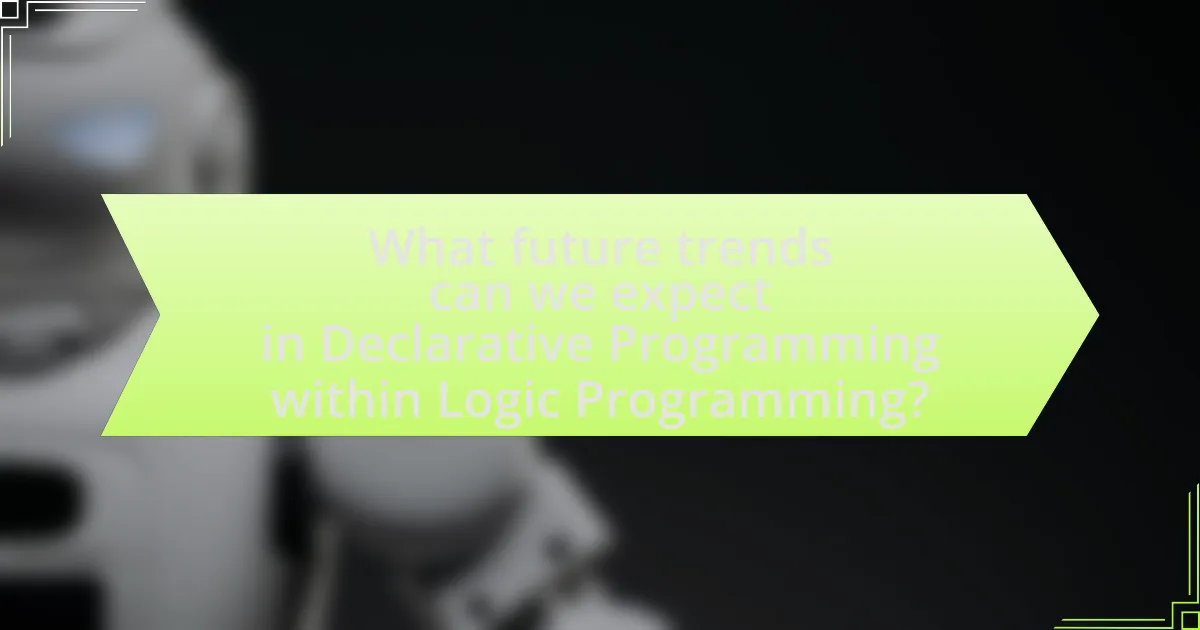
What future trends can we expect in Declarative Programming within Logic Programming?
Future trends in Declarative Programming within Logic Programming include increased integration with machine learning and artificial intelligence, enhanced support for parallelism, and the development of more user-friendly programming environments. The integration with machine learning allows for more adaptive systems that can learn from data while maintaining the declarative nature of logic programming. Enhanced support for parallelism is driven by the need for efficient computation in large-scale applications, enabling better performance in processing complex queries. Additionally, the development of user-friendly environments aims to lower the barrier to entry for new programmers, making declarative programming more accessible. These trends are supported by ongoing research and advancements in computational models, as seen in studies like “Declarative Programming in the Age of AI” published in the Journal of Logic Programming, which highlights the evolving landscape of logic programming in conjunction with emerging technologies.
How is the evolution of technology influencing Declarative Programming?
The evolution of technology is significantly influencing Declarative Programming by enhancing its efficiency and applicability in modern software development. Advances in hardware capabilities, such as increased processing power and memory, allow for more complex declarative languages to be executed faster and more effectively. Additionally, the rise of cloud computing and distributed systems enables declarative programming paradigms to scale seamlessly, facilitating the development of applications that can handle large datasets and complex queries with ease. For instance, technologies like SQL and functional programming languages have evolved to leverage these advancements, making it easier for developers to express logic without detailing control flow, thus improving productivity and reducing errors.
What advancements are being made in Logic Programming paradigms?
Recent advancements in Logic Programming paradigms include the integration of machine learning techniques, which enhance the ability of logic-based systems to learn from data and improve their reasoning capabilities. For instance, systems like Prolog have been augmented with probabilistic reasoning, allowing for more flexible and robust decision-making in uncertain environments. Additionally, the development of Answer Set Programming (ASP) has gained traction, enabling more expressive problem-solving capabilities through non-monotonic reasoning. These advancements are supported by research such as “Combining Logic Programming and Machine Learning” by Alviano et al., which demonstrates the effectiveness of these integrations in practical applications.
How might Declarative Programming adapt to new computational models?
Declarative programming can adapt to new computational models by leveraging its inherent abstraction and expressiveness to align with emerging paradigms such as quantum computing and neuromorphic computing. This adaptability is evident as declarative languages focus on what the program should accomplish rather than how to achieve it, allowing for easier integration with novel computational architectures that may require different operational approaches. For instance, in quantum computing, declarative programming can facilitate the expression of complex quantum algorithms without delving into the intricate details of quantum gate operations, thus streamlining the development process. Additionally, the rise of neuromorphic computing, which mimics neural architectures, can benefit from declarative programming’s ability to represent high-level logic and relationships, enabling more intuitive modeling of cognitive processes. These adaptations are supported by ongoing research that demonstrates the effectiveness of declarative paradigms in various computational contexts, highlighting their versatility and relevance in the face of technological advancements.
What best practices should developers follow when using Declarative Programming?
Developers should prioritize clarity and simplicity when using Declarative Programming. This approach emphasizes expressing the logic of computation without detailing control flow, which enhances code readability and maintainability. Additionally, developers should leverage existing libraries and frameworks that support declarative paradigms, as these tools often provide optimized solutions and reduce the need for boilerplate code. Furthermore, testing and validation should be integral to the development process, ensuring that the declarative statements accurately represent the intended logic. By adhering to these best practices, developers can create more efficient and understandable code, ultimately leading to better software quality.

